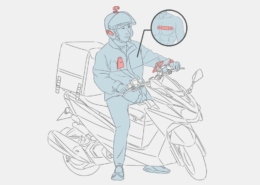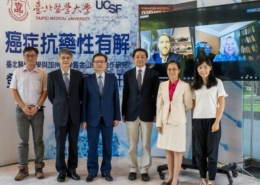TMU-UCL research tracks eye movements to seek psychiatry’s holy grail:
an objective measure of mental illness
TMU’s Brain and Consciousness Research Center and Graduate Institute for Health and Biotechnology Law have joined forces with one of the university’s most renowned European partners: Belgium’s 600-year-old Université catholique de Louvain.
Louvain Prof. Marcus Missal visited Dr. Tzu-Yu Hsu in November to set up a joint experiment with important implications for a better understanding of mental illnesses. Their findings could dramatically change both treatments and health policies.
The three-year project is testing whether eye movements are associated with severe depression and ADHD (attention deficit hyperactivity disorder), following Prof. Missal’s successful use of this non-invasive method with Parkinson’s patients.
“I’m interested in impulsivity,” he said. “It’s normal [for everyone], but with mental illness it could be increased. Moreover, some medical treatments could also increase impulsivity. For instance, in depression, it seems that serotoninergic transmission correlates with impulsivity.” But why come around the world to conduct a study with TMU?
Prof. Missal praised the university’s commitment and proactive approach to research. ”Thanks to open-mindedness here, there are many patients” who can participate in this research, he said. The initial cohort is 30 patients and 30 control subjects without mental illness.
Watching for wandering eyes
The goal is a precise measure of impulsivity using eye movements as a tool. Patients look at a screen where spots of lights jump to different positions and have the -instruction to follow them with the eyes, performing “visually-guided saccades” [fast eye movements]. “Premature saccades” are twitchy or bouncing glances before the jump of the spot of light and these may be associated with pathology or responses to treatment, as was found in Prof. Missal’s work with Parkinson’s patients.
He said in a November interview that this method seems reliable and could be used in conjunction with other measures of mental problems, such as questionnaires and diagnostic observations.
Along with its low cost, freedom from subjective bias is the new method’s potential value. Clinicians, scientists and health policy-makers have long sought such an objective measure for mental problems and responses to treatment.
People will come to the lab in TMU’s Shuangho Hospital so the system can record their eye movements. These recordings will be analyzed alongside four other kinds of data on the same 60 subjects: EEG (electroencephalogram) images of electro-cerebral activity and magnetic resonance images of neurotransmitter activity in different parts of the brain, as well as with questionnaires and medical records.
If the eye movements show solid associations, this interpretive method may be eagerly adopted by the medical community as preferable to more expensive, invasive and subjective measures.
Progress with Parkinson’s disease
Prof. Missal came to TMU for just five days on this trip, bringing his custom software and consulting with Dr. Hsu, then departing the day before testing was to begin. “It’s all up and running so I can go home,” he said. During his visit, he lectured on “Neurological evidence of a dual origin of temporal preparation” that provides useful insights into Parkinson’s disease.
He’s confident because “I did with Parkinson’s patients another test of the same method. It is useful, though not (yet) as a diagnostic so much as a way of following the efficacy of therapy.”
Dr. Hsu said there’re some limitations about current psychiatric diagnostic methods because the nature of these methods is largely subjective reports based. As the progress in neuroscience research evolved, instead of relied on clinicians’ experiences and patients’ reports, scientific approach may provide objective evidence by analyzing and integrating the five types of behavioral, biological and neuroimaging information, the researchers hope that this method can contribute to psychiatric diagnosis although it is still a long way to go. The preliminary testing expected to be done by year’s end.
Prof. Missal praised TMU’s willingness to devote resources to this research, as “not many people can do that” (administer the four kinds of tests and provide medical records on a useful number of patients within two months).
He said TMU is outstanding because all needed resources and facilities work together: “Everything is here, especially people who want to collaborate. They welcome outside research partnerships.”
A world of research collaborations
This TMU-UCL partnership is still growing, according to Prof. Missal: “I believe there’s a desire to develop more collaborative projects. But we have to go step by step, and get to know each other before writing grants” to do more research. He said he would also be looking for ways to give Louvain students a chance to participate in TMU research and other exchanges.
This inter-university cooperation is in its 8th year since an initial visit by two Louvain professors in 2010. More recently, a delegation of 15 Louvain scholars came for a research symposium organized by TMU.
This conference resulted in the two sides finding “common interests at the experimental level — and papers are pending” from these projects, Prof. Missal said.
Dr. Hsu noted that her college (of Humanities and Social Sciences) is growing fast. In the past year, it has expanded from a suite on the main campus to also extend to offices in the high-rise Da-An Campus, as well as establishing research facilities at Shuangho Hospital. “Especially thank TMU and Shuangho Hospital for supporting on doing neuroscience research,” Dr. Hsu said. “It is never easy to build a cross-disciplinary neuroscience research team without people’s support from TMU and three hospitals.”
Research complements TMU teaching
She said faculty members are recruiting international students with neurological, neuroscience and humanities interests because “they’re both based on humans, and everything is linked.” The master’s degree program is established and a Ph.D. program is eagerly expected to be approved soon.
Within its medical humanities mission, Dr. Hsu says her unit also serves the larger university by offering courses introducing students in clinical training programs like medicine and oral medicine to psychology. These basic courses are enhanced by the teachers’ expertise in biology and neuroscience research, which has resulted in many publications about neuroimaging and consciousness.
The Ministry of Science and Technology is supporting Dr. Hsu and Prof. Missal’s research. Yet its greatest impact might be in the Ministry of Health and Welfare and in other health insurance systems worldwide.
If the eye-movement method proves useful, insurers everywhere can confidently expand coverage for psychiatric services that are currently under-covered due to difficulties in proving need with subjective criteria — once there is finally a measure of psychological dysfunction that is lower in cost and more objective and versatile than ever before.
Prof. Marcus Missal has a 23-year track record of neuro-ocular research, and is also an honorary senior research associate at the Fonds National de la Recherche Scientifique (FNRS), Belgium’s top research institute. He has taught and conducted research in Paris, San Francisco and the University of Cambridge. He reviews for the Journal of Neurophysiology, Journal of Neuroscience, Experimental Brain Research, Cerebral Cortex, Journal of Vision, PlosOne, and Current Biology.
Dr. Tzu-yu Hsu came to TMU after years at National Taiwan University and Oxford University. Her research interests in experimental psychology and cognitive neuroscience include the neural mechanisms of visual attention and visual short-term memory, and the role of the prefrontal lobe and executive function in conflict/inhibitory control. Her research has recently appeared in Current Directions in Psychological Science, Journal of Neuroscience, Behavioural Brain Research, NeuroImage, Human Brain Mapping, and Frontiers in Human Neuroscience.
TMU’s Graduate Institute of Mind, Brain, and Consciousness unites scientists, clinicians and philosophers who investigate the levels and contents of consciousness. We conduct research into normal and altered states of consciousness through a range of techniques, including multi-modal brain imaging and brain stimulation. The aim of our research is to advance the understanding of what consciousness is and how it can be impaired. We hope these advances can be used to develop improved diagnoses and treatments for psychiatric and neurological disorders. We offer a master’s degree in cognitive neuroscience (PhD under way).
Website: http://gimbc.tmu.edu.tw/
The Research Center of Brain and Consciousness investigates the levels and contents of consciousness, along with the cognitive mechanisms that modulate these. Central to this work is the use of different brain imaging and stimulation techniques to directly measure and manipulate brain actions and understand how these work in health and disease.
Website: http://consciousbrain.tmu.edu.tw/
This article is simultaneously available on QS WOWNews.
For interviews or a copy of the paper, contact Office of Global Engagement via global.initiatives@tmu.edu.tw.

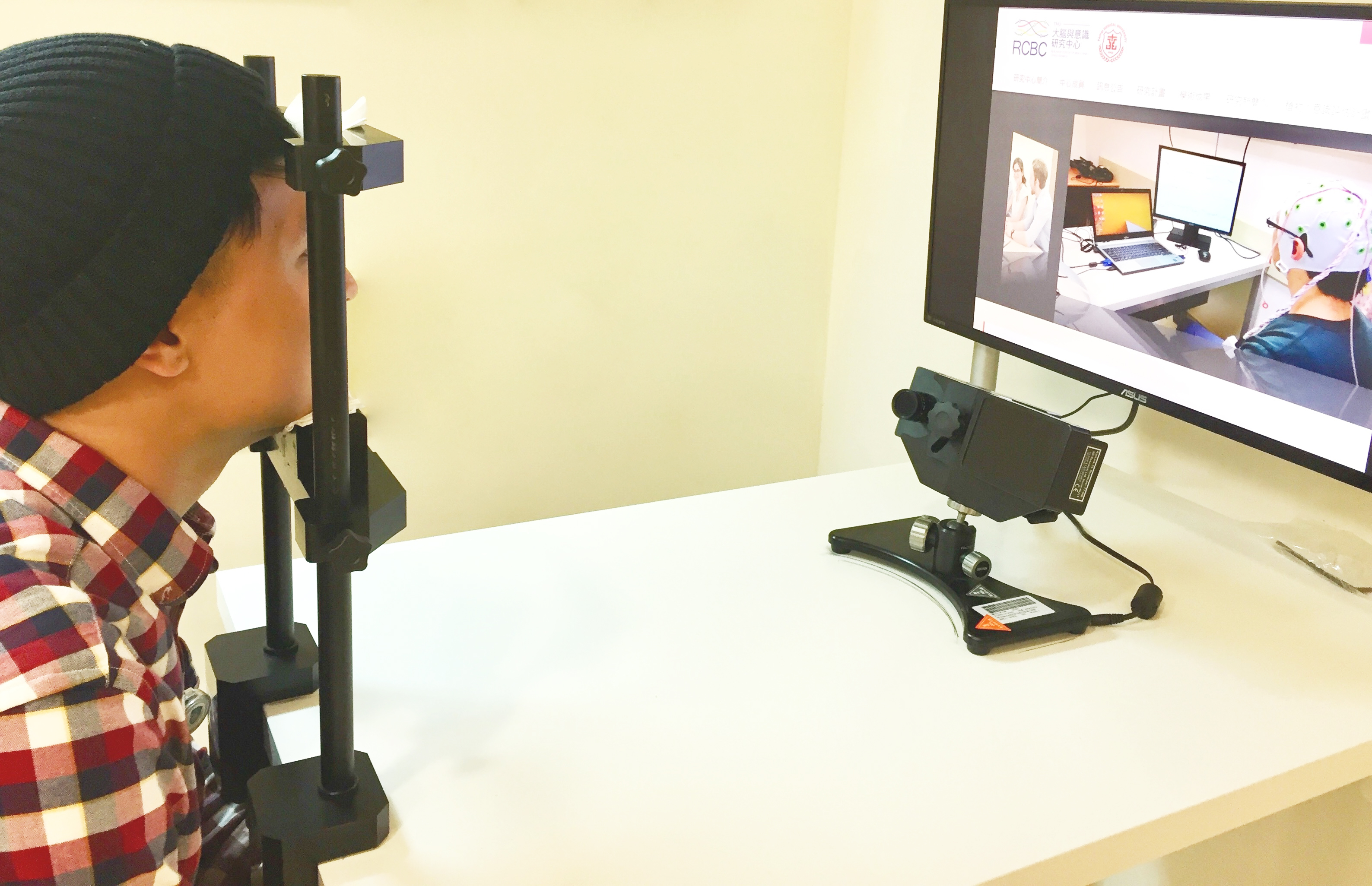
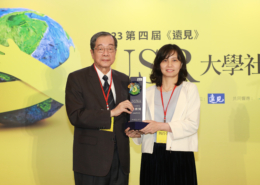
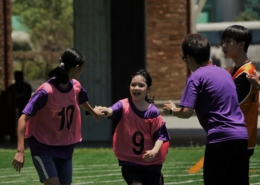
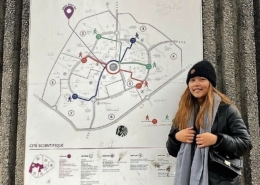

期許永續發展成為醫療產業新契機。-260x185.jpg)


